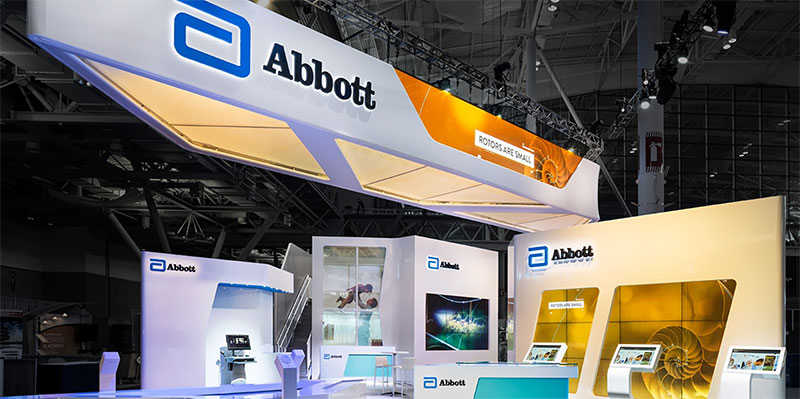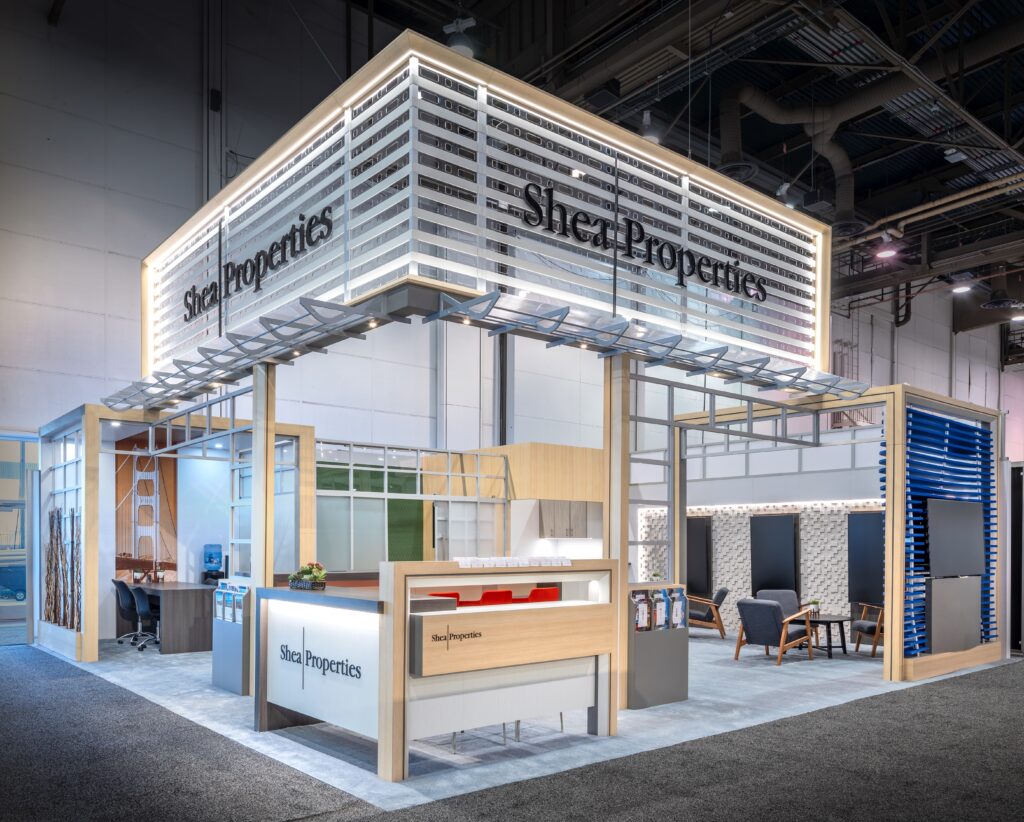You already have your brand story. You know your identity, your mission statement, and what your products or services are supposed to do.
You might even have a killer blog in place and an engaging social media presence.
But, get to the booth design process, and you’re stumped.
All of a sudden, your brand’s story includes more than words and pictures. There are emotions, touchpoints, and technology in the mix—a physical representation that makes a connection, while of course, inspiring people to buy a product, book an appointment, or at least leave an email behind.
A great story places the visitor at the center of the conversation. Which means you’ll need to go beyond what you sell by leveraging what you know about your audience and what resonates with them.
How to Choose the Best Visuals for Your Brand’s Story — Subscribe and download to check out our top tips
The Story Isn’t About You; It’s About Your Visitors
Brand stories can be tedious and self-indulgent.
We all like to think everyone is interested in “our thing,” but the truth is, people aren’t that excited to hear about something that has nothing to do with them.
As a brand, you risk more than boring party guests with your “me, me, me” monologue. Failing to take consumer interests, pain points, hopes, dreams, and curiosity into account means you’re not making money.
With that in mind, coming up with a compelling brand narrative is intimidating.
Before you look at VR headsets and touchscreen displays, you’ll want to collect some fundamental information:
- What makes your business unique?
- Is there something interesting about why your company was founded in the first place? Was it a solution to a common problem? A life-changing experience?
- What problem is your company trying to solve?
- What “aha” moments have you had?
- How has your business changed over the years?
- `What behind-the-scenes operations might your audience find interesting?
You know your brand, but you need to spend time getting to know your audience and what inspires them.
Clarify Your Messaging
You’ve thought about your audience; now it’s time to look at your brand basics. Every element of your booth, and any pre-show marketing efforts, need to connect to the following three components:
- Brand Promise: What are the key benefits that make your brand attractive?
- Value Proposition: Why/how does your product or service solve a particular problem?
- Value Description: In what way does your product or service improve someone’s life?
Everything you do should come back to these essential points, but within the context of your exhibit, it’s a nice reminder that every piece of your display—whether it’s a giveaway, a game, or a charging station—should tie into how you provide value.
Every piece of your display—whether it’s a giveaway, a game, or a charging station—should tie into how you provide value. Click To TweetLet’s use Zappos as an example.
If you look on their website, they’ve listed their 10 core values and linked them to behaviors that reinforce those values. Basically, they say who they are: a brand that cares about making others happy, but is a little quirky and out-of-the-box.
For instance, one value is delivering the “wow” factor through service, and the associated behaviors are being innovative, positive, and helping others even when it’s not their job.
This live event, a now-famous cupcake giveaway, reinforces those values. It’s whimsical, a little silly, and clearly, the story is about making people happy.
Connecting the Customer Journey to the Booth Experience
Okay, we’ve looked at the importance of defining your core value proposition and defining your customer.
Let’s bring it all together. Where does your brand link up to the touch points along your customer journey?
The goal is to map the customer challenges and pain points to a narrative arc. That said, we don’t mean that you need to write a novel about how your customers move from awareness to consideration to decision.
What we mean is, how can you make like Zappos and bring your culture to life in a way that delivers value to visitors and gets people talking? With that question in mind, let’s break down the “narrative components” you’ll need to consider.
Theme
Okay, theme in the context of your exhibition is all about what you want to say. How do you want your attendees to feel when they step into your booth? Basically, your goal here is to present your value proposition in a way that connects to people’s emotions.
Here’s a project we did for Orange Amps. Their theme, 50 years of Orange, plays into the nostalgia factor. The booth included rock and roll highlights from the past 50 years, and shows off how Orange’s branding has changed throughout the years, while hanging on to their legacy.
Players
Who do you want to showcase with your brand activation? Is it your people—founder and employees (i.e., are you launching a product or giving a virtual tour?) or the customer (the user takes center stage)?
Look at Beautyrest’s SXSW Sleep experience. The mattress brand created an experience where 150 strangers slept for eight hours, while composer Max Richter serenaded them with soothing sounds. Attendees were able to stop by and watch the concert, as sleepers lounged in Beautyrest twin mattresses.
The brand involved the audience by allowing people to sign up for the installation. Those people, placed at the center of the story, likely shared the experience on social media, told their friends about it, and drummed up some PR for the legacy mattress brand.
Setting
Do you want to transport your audience to a new environment?
This might mean turning your booth into a coffee shop or a bar where they can make custom cocktails. Or, you might use VR to take your audience behind the wheel of a race car or on a journey through wine country. Maybe this “place” only exists in your imagination.
In any case, it’s important to understand that whatever setting you decide to create should evoke an emotional response that connects to your brand.
When you consider the journey in the context of your website and marketing materials, there’s generally this clear progression where a first-time visitor moves from stranger to customer.
Story and Branded Games or Giveaways
Trade show booths are more about the “show” than anything these days. As such, brands that embrace their playful side stand to see some big-time benefits.
For one, who doesn’t want to cut loose after a long day of swapping business cards and listening to sales pitches?
An in-booth contest or video game is a great way to tell your story in a way that brings some excitement and participation into the mix.
Of course, any game element, VR experience, or giveaway needs to tie back to your customer goals and value prop.
For example, take a look at Docker, a software platform designed to help app developers create applications that work with different operating systems.
That might not sound like an inherently glamorous product, but as you can see here, they know how to put on a show.
The brand created a game called Docker Dash, which brought the company logo into an interactive simulation. And–it wasn’t just a game, players could unlock “enterprise mode” and all the “features” needed to complete the process of building an app.
As you can see in the video, the brand has created a really exciting, concert-like experience. But, the presentation brings it all back to what they do for their clients.
Brand Story as Live Demo
So, maybe you’re not dreaming up a video game that represents your brand or planning a buzzy installation. That’s okay. You can make yourself useful instead.
One of the main reasons that people go to trade shows is they want to see products and services up close. A live event provides something different than anything people can find online. As such, product demos are a must, especially if your product requires some education or you’re rolling out new features.
As you design product demos, make sure you center them around a specific need. Can attendees try the products for themselves?
It might not be practical to bring a full demonstration of your solution into the booth–if so, you may want to look into bringing a VR or AR demo into the mix instead.
What Do You Want Your Customers to Walk Away With?
We’re willing to bet that the reason your company has decided to exhibit is to increase brand awareness. Maybe you’re trying to get more leads or drive sales. At the core of all of those goals is brand recall. It’s not enough to create a memorable experience – you need to tap into that “aha moment.”
To do this, you may want to dedicate some booth space to reinforce your brand’s mission, message, and why you do what you do.
Off-the-shelf trade show booths aren’t our thing, and they shouldn’t be yours, either. We build immersive exhibits that command attention, delight attendees, and tell your story.
Echelon can turn your brand’s story into an unforgettable experience. Check out our past work to see what we can do.
Free Download: How to Choose the Best Visuals for Your Brand’s Story







